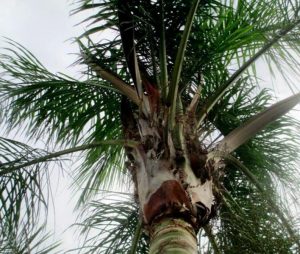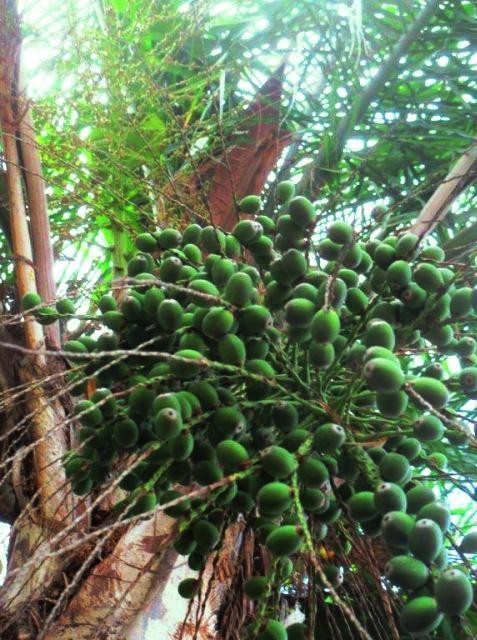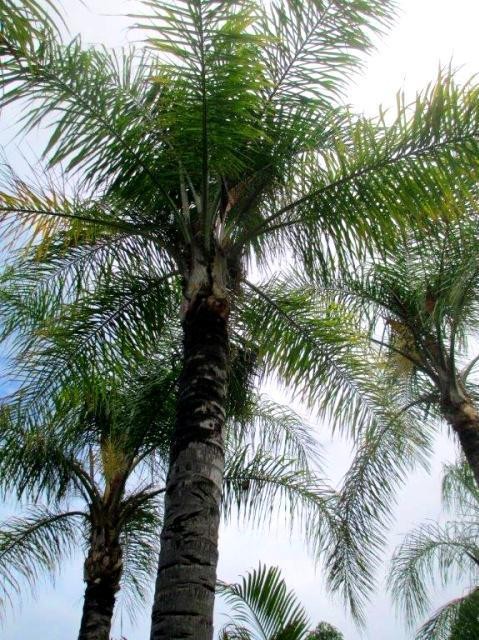By Tommy Clarkson from the July 2014 Edition
Syagrus romanzoffiana
Family: Arecaceae
Also known as: Cocos Palm

(A “newbie” to palm inquired, “So Tommy, what are your thoughts on the Queen Palm?”
The curmudgeony, highly opinionated, rather grey headed grump, with dirt encrusted fingernails and torn shorts, fast responded. ”Well, right off the top of my head, tawdry, tacky and tasteless the palm tree equivalent of a human oxygen bandit comes to mind!” )
From the very outset I heartily apologize to fans of this palm as I realize it has no few advocates. But I am among its detractors. In fact, this is, probably, the only palm that will never be given a home in Ola Brisa Gardens. To my opinionated way of thinking, the scrawny, somewhat scant, limp leaflets of this pinnate palm that hang listlessly above it mangy looking crownshaft, may well be the best of its features! Perhaps the next best thing I can think of to say about the Syagrus Romanzoffiana is that they are immune to the lethal yellow disease.
Recently, I noted on-line that a Florida nursery obviously an entity in the business of selling palms described the Queen Palm as a “stately, single-trunked palm crowned by a beautiful head of glossy, bright green, soft, pinnate leaves forming a graceful, drooping canopy.” To me “marginally” graceful they might be, at best.
Now, before denigrating this poor, pathetic plant further let me cut it a bit of slack. As my dear, saintly Grammy used to say, “There’s a little good in every palm.” OK, OK, she may have said “everybody” but let’s not split fronds about it. You get the point.
Its “formal” name honors an 18th century count and is the Latinized form of the Russian surname Romanzoff. This species of palm was long known as Coco Plumose with many people still calling it that. And, in spite of what all I consider its several short-comings, it can be grown outside in most all tropical areas. Beyond that, its leaves and fruit can be fed to livestock and the seeds crushed and fed to poultry. Lastly, the trunks are sometimes used in salt water piers as they are immune to marine bore worms.
One thing a person can say about the Syagrus Romanzoffiana is that it’s a fast grower. (That’s why so many developers plant them in new housing divisions sort of “instant tropics”.) They can reach an ultimate height of 25 to (in optimal conditions) nearly 50 feet (7 ½ -15 ½ meters) with a spread of 15 to 25 feet (4 ½ – 7 ½ meters). Its sparse fronds – fifteen or so – are ten to fifteen foot long and sport limp, lackluster leaflets of around 18 to 36 inches (46 -72 cm) in length. Its flowers are white, cream and/or grayish and its round, fleshy orange fruits are between ½” to an inch and a quarter (1 ¼ – 3 ¾ cm) in size. Those “ornamental” fruits hang in clusters. The grey, smooth sometimes slightly bulging, trunk is ringed with old frond scars.
Originally ranging from southern Brazil to Argentina, the Queen Palm likes full sun. As to soil needs, it can do just fine in clay, sand or a loamy mix even acidic as long as it is well draining. Alkaline soil is not its friend. Such will disfigure the palm by stunting the young leaves and can actually kill it. If planted in soil of alkalinity, applications of manganese and/or iron are necessary to help keep the fronds green. This manganese deficiency can cause “Frizzletop” which is a common problem if not regularly fertilized. Yet another mineral problem, that of potassium deficiency, shows up on older fronds, even in well-drained soils. Mildly salt tolerant, the Queen Palm responds well to ample moisture and – I repeat myself – fertilizer.
For reasons wholly lost upon me, other than its fast growth, it is often used as a focal point palm, for framing a house, in commercial landscape venues or planted in rows on 15 foot centers lining streets or walks. With so very many, truly majestic palms available, this simply boggles my mind!
My foremost objection to the Queen Palm are its old dried and raggedy frond stubs protruding, all too often, beneath, what I perceive as a scant and meager canopy.
Beyond that the Queen Palm is weak rooted. Lastly as I totally pan this poor, pathetic palm – is the fact that its copious quantities of fruit are considered by many to be a messy problem and, hence, one more detraction.


For back issues of “Roots”, gardening tips, tropical plant book reviews and videos of numerous, highly unique eco/adventure/nature tours, as well as memorable “Ultimate Experiences” such a Tropical Garden Brunches and Spa Services, visit us at.. www.olabrisagardens.com
Download the full edition or view it online
—
Tommy Clarkson is a bit of a renaissance man. He’s lived and worked in locales as disparate as the 1.2 square mile island of Kwajalein to war-torn Iraq, from aboard he and Patty’s boat berthed out of Sea Bright, NJ to Thailand, Germany, Hawaii and Viet Nam; He’s taught classes and courses on creative writing and mass communications from the elementary grades to graduate level; He’s spoken to a wide array of meetings, conferences and assemblages on topics as varied as Buddhism, strategic marketing and tropical plants; In the latter category he and Patty’s recently book, “The Civilized Jungle” – written for the lay gardener – has been heralded as “the best tropical plant book in the last ten years”; And, according to Trip Advisor, their spectacular tropical creation – Ola Brisa Gardens – is the “Number One Tour destination in Manzanillo”.




You must be logged in to post a comment.